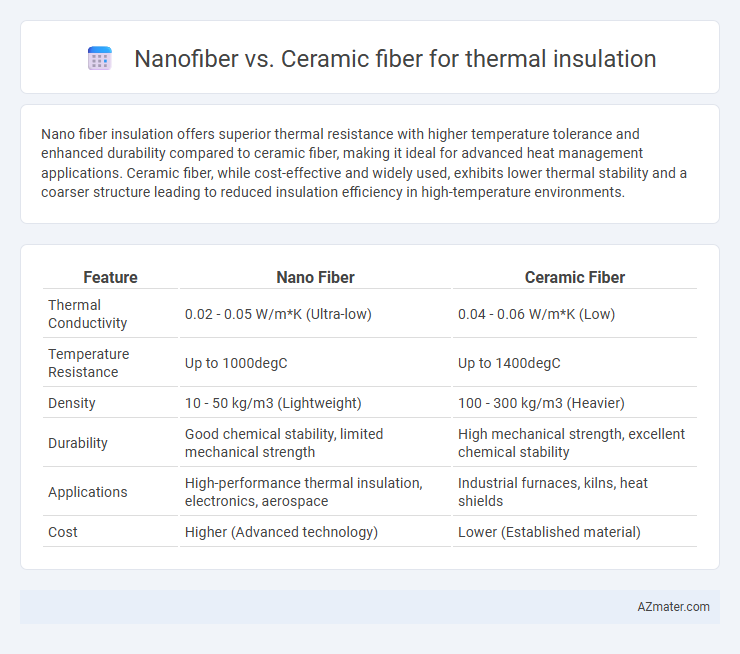Nano fiber insulation offers superior thermal resistance with higher temperature tolerance and enhanced durability compared to ceramic fiber, making it ideal for advanced heat management applications. Ceramic fiber, while cost-effective and widely used, exhibits lower thermal stability and a coarser structure leading to reduced insulation efficiency in high-temperature environments.
Table of Comparison
| Feature | Nano Fiber | Ceramic Fiber |
|---|---|---|
| Thermal Conductivity | 0.02 - 0.05 W/m*K (Ultra-low) | 0.04 - 0.06 W/m*K (Low) |
| Temperature Resistance | Up to 1000degC | Up to 1400degC |
| Density | 10 - 50 kg/m3 (Lightweight) | 100 - 300 kg/m3 (Heavier) |
| Durability | Good chemical stability, limited mechanical strength | High mechanical strength, excellent chemical stability |
| Applications | High-performance thermal insulation, electronics, aerospace | Industrial furnaces, kilns, heat shields |
| Cost | Higher (Advanced technology) | Lower (Established material) |
Introduction to Thermal Insulation Materials
Nano fibers offer superior thermal insulation due to their extremely small diameter and high surface area, which significantly reduces heat transfer by minimizing conduction and convection. Ceramic fibers provide excellent high-temperature resistance and stability, commonly used in industrial applications requiring durability and fire resistance up to 1,260degC or higher. Comparing both, nano fibers excel in lightweight insulation and energy efficiency, while ceramic fibers are favored for their robustness and long-term structural integrity in harsh environments.
Understanding Nano Fiber Technology
Nano fiber technology in thermal insulation utilizes ultra-fine fibers with diameters less than 100 nanometers, resulting in significantly higher surface area and enhanced heat resistance compared to traditional ceramic fibers. This advancement enables superior thermal barrier performance, reduced thermal conductivity, and increased durability under extreme temperatures. Applications of nano fiber insulation include high-performance aerospace, automotive, and industrial sectors where efficient thermal management is critical.
Overview of Ceramic Fiber Insulation
Ceramic fiber insulation consists of lightweight, refractory fibers made primarily from alumina and silica, designed to withstand temperatures exceeding 2600degF (1427degC). Its high thermal stability, low thermal conductivity, and excellent resistance to thermal shock make it ideal for industrial furnaces, kilns, and pipe insulation. Compared to nano fiber insulation, ceramic fibers offer superior mechanical strength and durability in extreme high-temperature environments, ensuring enhanced energy efficiency and safety.
Thermal Conductivity: Nano Fiber vs Ceramic Fiber
Nano fiber insulation exhibits significantly lower thermal conductivity compared to ceramic fiber, typically ranging from 0.02 to 0.04 W/m*K, making it highly efficient for minimizing heat transfer. Ceramic fiber usually has a thermal conductivity between 0.12 and 0.28 W/m*K, which is higher due to its micro-scale fiber structure and less effective heat barrier properties. The superior insulation performance of nano fibers is attributed to their ultrafine diameters and increased surface area, which reduce heat conduction and enhance thermal resistance in industrial and high-temperature applications.
Heat Resistance and Operating Temperatures
Nano fibers exhibit superior heat resistance compared to ceramic fibers, with the ability to maintain thermal stability at temperatures exceeding 1,000degC, making them ideal for high-performance insulation applications. Ceramic fibers typically operate efficiently within the 1,000degC to 1,200degC range but may degrade faster under prolonged exposure to extreme heat. The nanoscale structure of nano fibers provides enhanced thermal barrier properties and lower thermal conductivity, resulting in better insulation performance in high-temperature environments.
Mechanical Strength and Durability Comparison
Nano fiber insulation exhibits superior mechanical strength due to its finer fiber diameter and higher tensile properties compared to ceramic fiber, resulting in enhanced structural integrity under stress. Ceramic fiber offers excellent durability at high temperatures, maintaining stability and resistance to thermal degradation in extreme environments. The combination of nano fiber's flexibility and ceramic fiber's thermal resistance makes each suitable for different insulation applications depending on mechanical and durability requirements.
Energy Efficiency and Performance
Nano fiber insulation exhibits superior thermal resistance due to its ultrafine fiber diameter, resulting in lower thermal conductivity and enhanced energy efficiency compared to traditional ceramic fiber. The high surface area of nano fibers improves heat retention and minimizes heat loss, making them ideal for applications requiring precise temperature control and reduced energy consumption. Ceramic fibers, while effective at high temperatures and resistant to thermal shock, generally have higher porosity and thermal conductivity, which can lead to lower overall performance in energy-saving insulation systems.
Environmental Impact and Sustainability
Nanofiber insulation offers exceptional thermal resistance with lower material usage, reducing waste and energy consumption during manufacturing compared to ceramic fiber. Ceramic fibers, often derived from non-renewable mineral sources, pose environmental concerns due to energy-intensive production and potential health risks from airborne fibers. Nanofibers typically enable better recyclability and compatibility with eco-friendly composites, enhancing overall sustainability in thermal insulation applications.
Cost Analysis and Economic Viability
Nano fiber insulation materials typically exhibit higher upfront costs compared to ceramic fiber due to advanced manufacturing processes and superior thermal performance. Ceramic fibers offer cost-effective solutions with established supply chains and widespread industrial use, making them economically viable for large-scale applications despite slightly lower efficiency. Considering long-term energy savings, nano fiber insulation can provide better return on investment, although initial capital expenditure remains a critical factor in decision-making for thermal insulation projects.
Applications and Industry Use Cases
Nano fiber thermal insulation offers superior heat resistance and low thermal conductivity, making it ideal for advanced aerospace and electronics industries requiring lightweight, efficient thermal barriers. Ceramic fiber insulation excels in high-temperature industrial applications such as metallurgy, power plants, and furnace linings due to its exceptional thermal stability and durability at extreme temperatures. Both materials serve critical roles in sectors like automotive and construction, with nano fibers providing enhanced insulation for compact electronic devices while ceramic fibers protect heavy machinery from heat degradation.

Infographic: Nano fiber vs Ceramic fiber for Thermal insulation
 azmater.com
azmater.com